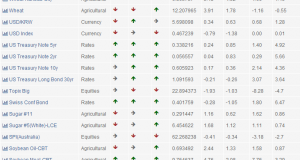Year Return: -5.91% (after commissions, slippage, 2% fixed fee)
Historically, years with turbulent equity markets and global crises has meant strong performance for diversified futures but this year was different. Clearly the trend followers struggled during 2012 and we have to ask ourselves what went wrong and why. The performance is not in any way out of proportions in regards to simulations although there is no way we can say that this was a good year. For a large part of the year we failed to keep up with the equity market in a sideways choppy market and by mid-summer we were quite far behind. As the equities tanked on the European crisis in July and August, we had a substantial gain and a very large lead over the equity crowd but this turned out to be a short lived victory as we started dropping in October and continued down for the rest of the year.
The return profile for the year is in line with most CTA funds and I will return with a detailed comparison to them once they have all released their end of year results. Some funds did considerably better, others considerably worse but most have a similar profile. There are three main factors which separates most CTA funds and while there are many different choices which would all produce strong long term results, in a single year such as this luck have more impact than one thinks. The three factors are time frame, investment universe and risk factor and in this particular year, the choice of investment universe was the big differentiator. The trend following money this year was primarily in the rates sector and those who have downweighted this in their investment universe suffered more than others. Next year the opposite may be true, who knows. This is the reason that the core strategy on this website uses a very large universe covering a large number of instruments in all sectors. One sector may keep losing year after year, only to make massive returns suddenly and make up for all the lost years.
What we can see in the sector chart here is that not only was rates the only sector showing a profit, it was quite a large profit and it was all made in a matter of weeks. In the middle of summer it looked as if yields could not go any lower and it would have been a fair conclusion that the upside in rates futures is limited but it would also have been serious mistake to alter the strategy based on this conclusion. If you missed the move in the long rates in early August, you would have missed out on the biggest move of the year and your performance would have been significantly worse at the end of the year.
The equity sector performed quite badly for most of the year although it did recover during a brief spike in the short trades when the markets were under sever stress in August. Over the long run, the equity markets are not terribly interesting as far as trend following futures are concerned. They tend do show too high internal correlation and the trends are getting more and more choppy. Still, they should not be removed from the universe as there are years which can be completely saved by having them in there.
As usual the bulk of the returns come from the long side. The short side of trend following has always been notoriously tricky and most years it’s just not profitable. Again, if you don’t keep doing it anyway, you will regret it the year where the short side saves your bacon. Even in a year like this, with a clear and strong bear market in equities, the short side lost money. There are two main reasons for the short side to be trickier. First there is the phenomenon that bear markets in most markets tend to show much higher volatility and you can easily get pushed out of a position in a violent counter move. The other reason is that even for the good positions, the more they go in our favor, the smaller the position gets. The opposite is true for long positions, where successful positions grow in size as they build profits and there it works in our favor. For the shorts we don’t get that advantage.
The period around August was truly amazing to live through where the chaos in the markets were approaching the levels of 2008 and some markets went absolutely crazy. The most interesting trade of the year occurred during this period and there is no doubt in my mind that the honor of most interesting trade of 2011 should go to the long Euro Swiss Franc. This is the 3 month CHF rate, not the currency cross. We went long in May already, having nice profits on the position in early August, but then the odd market began. As the European crisis worsened, money poured into the Swiss Franc safe haven currency while the central bank desperately tried fighting them off, wreaking havoc in both FX rates and interest rates. The magnitude of the moves in the Euro Swiss that occurred were completely out of proportion and there was a period where the marked priced in a negative interest rate in the CHF Libor, implying that banks would pay for the privilege of lending out unsecured money. Fundamental madness aside, we ended up with a substantial profit on this position before closing the position out in a violent counter move. These situations are rare, but if you are the right side they are quite fun to watch.
And how did the strategy compare against the competition? Let’s answer that in a later post, once all competitors have released their end of year results.
 Following the Trend
Following the Trend







